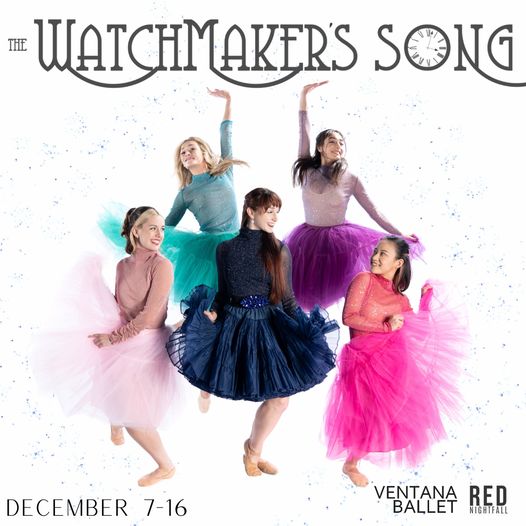Review: The Watchmaker's Song by Ventana Ballet
by David Glen Robinson
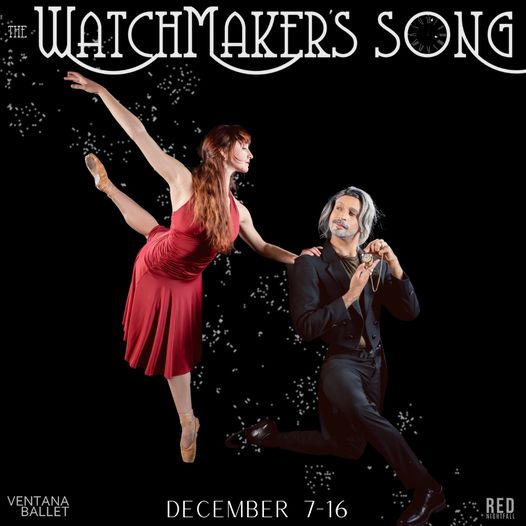 In The Watchmaker’s Song by Ventana Ballet and Red Nightfall Dance Theatre, the sugar plums are sprinkled with extra magic and the flavor is tasted in our imaginations. In hoary ancient times, a curse was leveled against a hero (Aidan DeWitt), who became the robotic and mysterious nutcracker. The Watchmaker, an equally mysterious supernatural being played by Navaji David Nava, makes a magic watch to counteract the evil. As we might expect, the Watchmaker’s superpower is mastery of all time. He fast-forwards us to the 19th century and the home of his niece, Clara (Kanami Nakabayashi). The event at which we arrive is the holiday party that centers upon the action of the well-known Nutcracker Suite.
In The Watchmaker’s Song by Ventana Ballet and Red Nightfall Dance Theatre, the sugar plums are sprinkled with extra magic and the flavor is tasted in our imaginations. In hoary ancient times, a curse was leveled against a hero (Aidan DeWitt), who became the robotic and mysterious nutcracker. The Watchmaker, an equally mysterious supernatural being played by Navaji David Nava, makes a magic watch to counteract the evil. As we might expect, the Watchmaker’s superpower is mastery of all time. He fast-forwards us to the 19th century and the home of his niece, Clara (Kanami Nakabayashi). The event at which we arrive is the holiday party that centers upon the action of the well-known Nutcracker Suite.
The Watchmaker’s Song reworks the ballet that has driven so many little girls headlong into ballet. For this annual show A.J. Garcia-Rameau is both the executive producer and the Sugar Plum Fairy. Dorothy O’Shea Overbey is the artistic director, choreographer, writer, and the Snow Queen.
Tikiri Shapiro plays Dame Mouserink. She is the queen of the home and a dark figure who steals the magic watch Clara uses to release the robot nutcracker from his curse and enjoy a meaningful romance with him. He initially reverts to stiff immobility. The avaricious Dame Mouserink’s superpower is deception. Tikiri Shapiro embodies the character fully and exemplifies the high talent required to perform with Red Nightfall Dance Theatre (hereinafter Red Nightfall) and Ventana Ballet. Their performers must combine stage acting talent, the kind that arises from within, with the great measured and trained physical skills of ballet. Shapiro has them all.
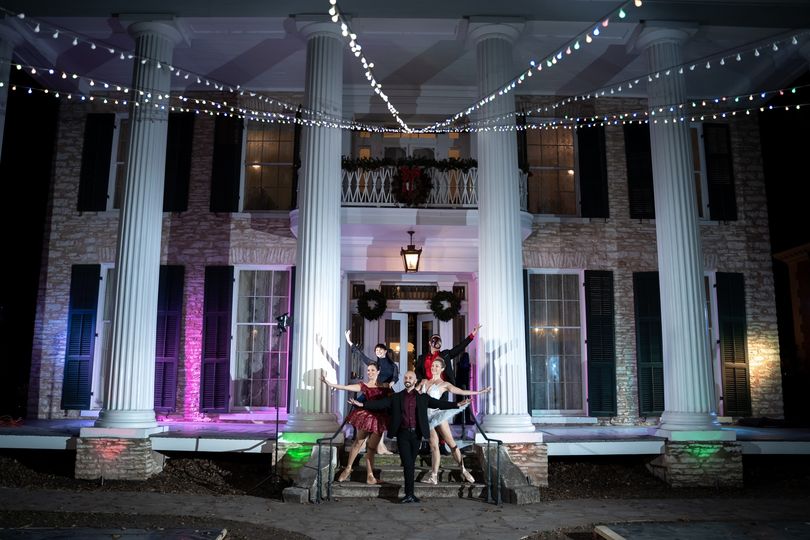
The first act takes place on the front lawn of the Neil-Cochran House Museum before its towering white-columned front porch. The columns conceal artifice (lighting instruments) and performers awaiting their entrances The regal Princess Perlipat (Jane Schwartz) observes all from one corner, only occasionally joining the festivities. Her origin and role in the story pantheon are never quite explained. All others enact story roles in dance at Clara’s party. And what dances they are! Committed professional dancers perform excellent ballet solos, duets, and ensemble dances, with the upward-reaching and leaping accents and highlights for which ballet is known. The group lifts are especially high and impressive, even more so when one realizes that everyone is clad in character costumes not always accommodating of dance. Tchaikovsky’s music was blended with Duke Ellington’s big band jazz to drive the performances to greater musical heights. Rachel Cox Culver positively glows. She performs smoothly through her character and her dance, always making it look easy. But kudos to all, they transported us easily to the fantasy castle that is the Nutcracker Suite. Additional Act I performers were Josh Martinez, Mia Moi, and Ripley Mayfield.
Then the Watchmaker opened the front door of the mansion and beckoned us inside.
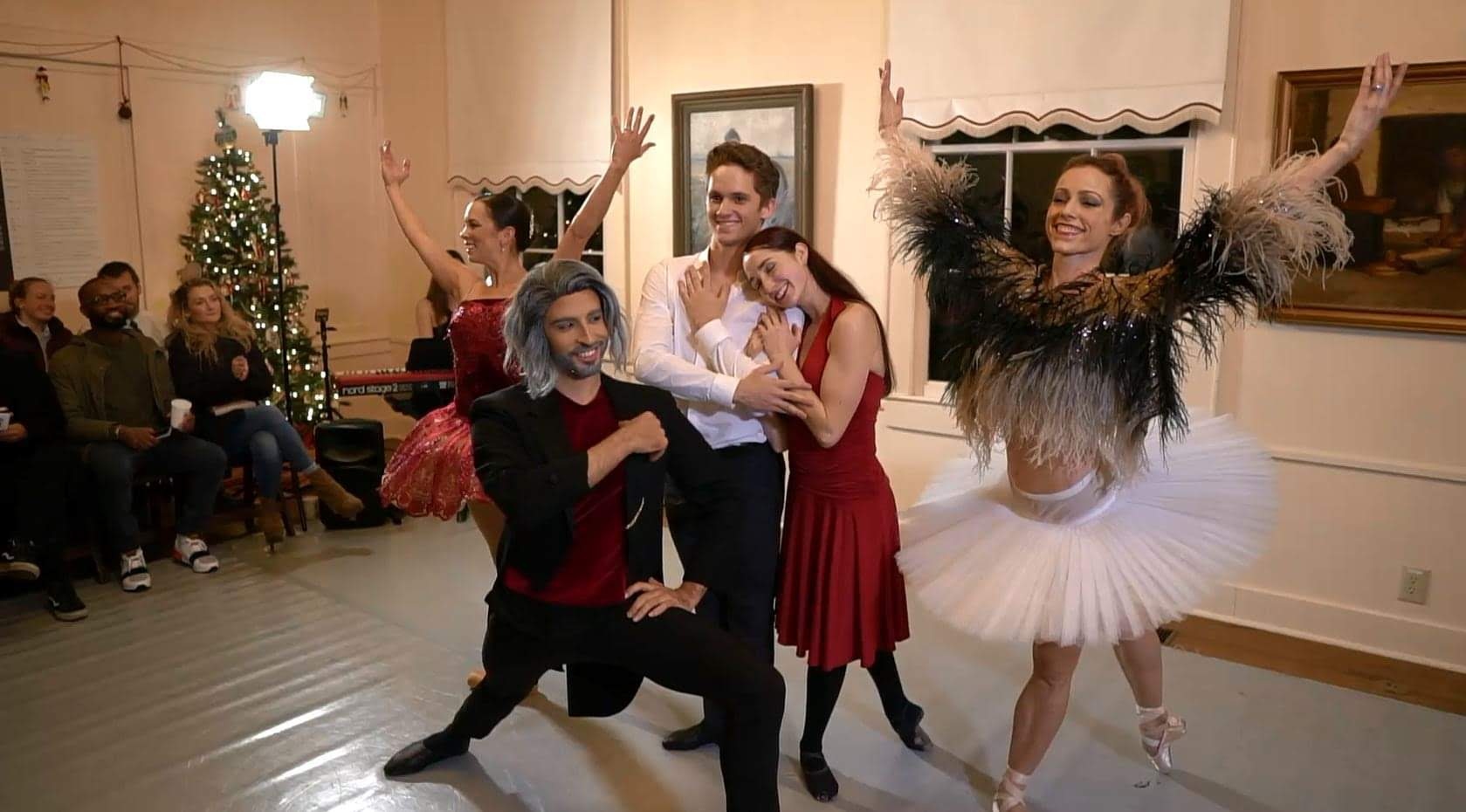
The Nutcracker fairy tale originated in elements of several early 19th-century horror stories by Prussian writer and jurist Ernst T.A. Hoffman. The holiday ballet staple we have come to know as the Nutcracker Suite comes from an 1892 ballet, its book lightened in its storytelling by Alexandre Dumas (The Three Musketeers, The Count of Monte Cristo, The Man in the Iron Mask) and set to music by Pyotr Ilyich Tchaikovsky (Piano Concerto No. 1, Swan Lake). The ballet became hugely popular through the twentieth century, largely due to Tchaikovsky's music. Many choreographers have modified or tinkered with it. Most notable for this reviewer was Mark Morris’s The Hard Nut, a postmodern version broadcast on PBS some decades ago.
Dorothy O’Shea Overbey wrote this reimagining, which premiered in 2017. She minimizes the horror-story elements in favor of the values and tropes of fairy tales. The figure of Drosselmaier, Clara's mysterious uncle, becomes the fully explained Watchmaker. He holds little mystery now, but Navaji David Nava depicts the wonder, charm, enchantment, and magic of the character. Serving as psychopomp, Nava leads the audience into and through the show, doing much to give the production its strong claim to being an immersive performance. He plays his magic cloak to perfection.
Overbey’s book retains the structure of the popular ballet. Instead of causing a war under the Christmas tree, the Nutcracker’s curse is lifted for happily-ever-aftering through magic and several dances, and the audience is invited into the mansion to witness Part 2 of the show. That section is a suite of ethnic and cultural folk dances originally seen as chocolate-box confections of music and dance. Nowadays they may be disparaged as a collection of cultural appropriations (but note: Tchaikovsky was Russian, and the Dance of the Cossacks is . . .claimed by Russia but is actually Ukranian . . .oh, well!). Though they're agreed to be beautifully wrought works of art, many question performing them today.
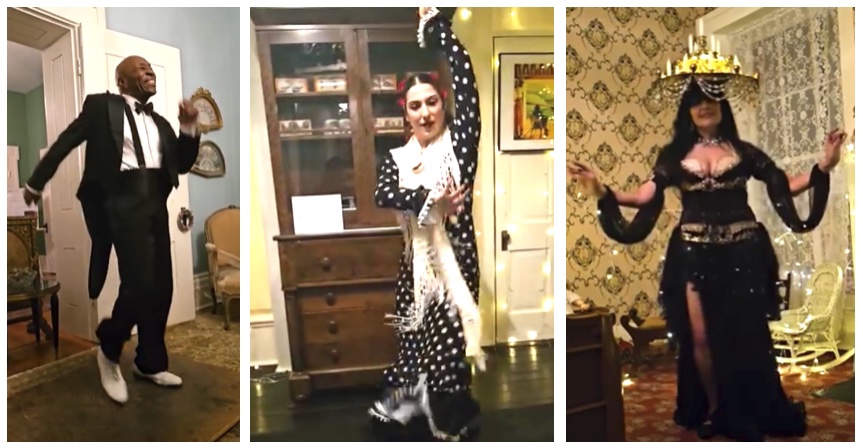
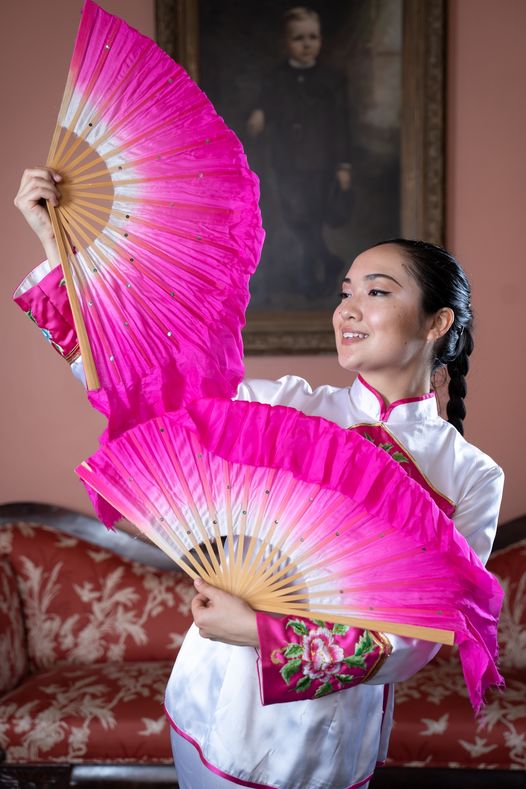 But with controversy comes opportunity. Overbey and Red Nightfall chose to invite Austin artisans of ethnic and folk dances to create the dances featured in sections of Act II. This strategy has been a successful adaptation from the beginning of a show now in its sixth year. Participating groups included the school and company Esquina Tango (ET), which sends different performers each night.
But with controversy comes opportunity. Overbey and Red Nightfall chose to invite Austin artisans of ethnic and folk dances to create the dances featured in sections of Act II. This strategy has been a successful adaptation from the beginning of a show now in its sixth year. Participating groups included the school and company Esquina Tango (ET), which sends different performers each night.
On my night, I saw ET partner Monica Caivano dance with Maggie Aguero. Another young woman dancer did not volunteer a name, so her recognition must wait for another time. Rania Kandil demonstrated Egyptian bellydance. Stephanie Keeton performed Spanish flamenco. The online program listed the following number as American tap dance, which it is, derived from a traditional African-American form. Movin’ Melvin Brown, the Austin master of the form, gave a demonstration while singing a Stevie Wonder hit from the 1970s. Brown’s dance and song were the stand-out performance gem—thoroughly unexpected, emotionally rich, and fresh as every sunrise. Brown’s section pitched The Watchmaker’s Song well into artistic brilliance, although not much much of a push was required.
The finale gave us Mother Ginger and the famous classic dances of the Sugar Plum Fairy and the Snow Queen, reprising Tchaikovsky in full. Mother Ginger is always a guest artist, and this year she was drag queen Colleen DeForrest in a black sequined gown, who led the audience and the dolls (Lilli Amdahl and Arianna Sotero) in a full-out production number that warmed the over-airconditioned banquet room.
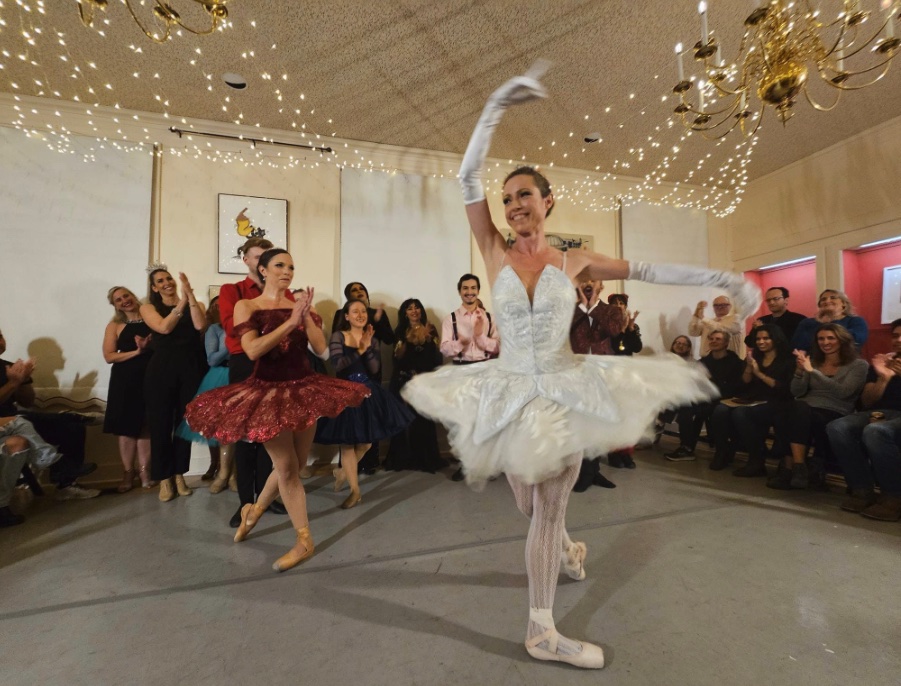
A.J. Garcia-Rameau entered and delivered the Dance of the Sugar-Plum Fairy to well-practiced ballet perfection in an exquisite plum-colored (of course!) gown and tutu made by the performer herself, and traditional toe shoes. Then it was Dorothy O’Shea Overbey’s turn to excel as the Snow Queen, similarly garbed though apparently in snow and ice, in great contrast to the Sugar Plum Fairy. The show ended with flourishes, applause all around, and tours of the Neil-Cochran House Museum.
The venue is now a museum dedicated to the era of slavery in Texas, including Austin’s history and the Neil-Cochran property’s participation in it. The system and the labor of the enslaved accumulated the wealth that built the home. Many think simplistically that all of America is a white-pillared mansion built with the blood and lives of the enslaved. The museum provides a full and candid acknowledgement of period and its economy. It acknowledges what came before, shows what now exists, and anticipates the future. It is a highly respectable and welcoming venue for these performances.
The quality of immersiveness is at times elusive. Yet the word is on the posters and publicity material of the two companies involved here, for this dance show and others. Their audiences willingly participate, dropped into the cauldron and led through the show, “playing audience.” We are in the bubble, physically inside the theatre/mansion, co-creating this modern updating of an iconic Western holiday work of art. The art focuses lightly on abundance and gratitude for what we have, in contrast to the historically dark, oppressive, somewhat brooding atmosphere of the mansion around us. Overbey and Garcia-Rameau give us a plot twist or perhaps a gravity wave that tumbles it all and reverses time. Or maybe it is the magic sprinkled on the sugar plums. The holiday fairy tales and their trappings seem to immerse themselves in the harsher historical realities, as opposed to the audience immersing itself in them.
A thought experiment: engage in your own brief retelling of the Nutcracker fairy tale. Clearly, the enchanted and cursed robot nutcracker is enslaved, disempowered, a being with a sobriquet but no name. The Watchmaker masters technology even more than time, and his agency and powers verge on the realm of magic. His intentions are good, at least benign. But it is Clara, mighty Clara, who understands the vast potential of the captive soul and doesn’t fail to ally herself with him. Her vision of the future is hope, and she takes the first few steps toward it, past all the guests reveling in materiality.
The production of the yearly feature show is bafflingly complex, from securing the venue (all six years of performances have taken place at the Neil-Cochran House Museum), to lining up the guest artists, hiring the feature dancers, designing sets and costumes, rehearsing, rehearsing, rehearsing, etc. Dorothy O’Shea Overbey and A.J. Garcia-Rameau have a complex partnership well more than competent to deal with it all. Overbey is the founder and artistic director of Red Nightfall productions and an artistic advisor to Ventana Ballet. Garcia-Rameau is the artistic director of Ventana Ballet. Together, Overbey and Garcia-Rameau are co-owners and partners of First Street Studio, the growing dance incubator on the east side.The two artists produce and perform in several events per year. Follow both companies to their next show. The rewards will great.
The 2023 edition of The Watchmaker’s Song runs until December 16, 2023, at the Neil-Cochran House Museum near the University of Texas campus in downtown Austin.
The Watchmaker's Song
by Ventana Ballet artists
Ventana Ballet
December 07 - December 16, 2023
